Integration of Electric Vehicles and Renewable Energy in Indonesia’s Electrical Grid
Abstract
1. Introduction
2. Literature Review
- They transform the dispersed emissions arising from conventional gasoline vehicles, which are challenging to manage, into centralized emissions from power plants, which can be more effectively controlled. These emissions can then be addressed using ultra-low emission technologies within power plants, thereby reducing pollution levels [16].
- EVs may be able to enhance the flexibility of the power system through V2G technology, aiding the integration of intermittent renewable energy sources. This V2G approach encompasses controlling charging from, and/or discharging to the grid so as to coordinate EV charging with grid load fluctuations and utilizing EV batteries to bolster the energy storage capacity of the power system [21,22,23].
3. Methodology
3.1. The Electricity System
3.2. Modeling Approach
- Energy Balance
- 2.
- Feasible energy dispatch
- 3.
- Feasible build
- 4.
- Renewable energy target
3.3. General Parameters in the Model
3.4. EV Modeling and Charging Stations
3.5. Deployment Scenarios
3.6. Scenario Formulation
3.7. Treatment of Vehicle-to-Grid Charging Costs
3.8. The Main Contribution of the Paper
- The study assesses the impact of EV integration on the optimal configuration and operation of the electricity grid. This assessment considers the penetration of renewable energy sources, the evolution of power generation, the deployment of battery systems, and the resulting emissions. The study delves into the intricate interdependencies between these factors, offering a comprehensive understanding of the potential ramifications of EV integration.
- The adoption of an hourly energy flow analysis. By capturing the nuanced fluctuations in energy demand and supply on an hourly basis, the study offers a holistic perspective on the challenges and opportunities of EV integration. This temporal granularity allows for a more nuanced evaluation of EV impacts on energy systems, bridging the gap between real-world dynamics and modeling outcomes.
- The utilization of real-world electricity generation data from Indonesia. This incorporation enhances the accuracy and applicability of the analysis, aligning the findings with the actual conditions of the country’s energy landscape. By grounding the analysis in empirical data, the study offers insights that resonate with Indonesia’s energy context and transition goals.
- The study is the first of a comprehensive assessment of EVs’ impact and contribution in Indonesia toward net zero emissions by considering the hourly variation in power generation, transmission power flow, demand and dispatch of renewable energy resources combined with battery investment in the provinces in Java–Bali and Sumatra.
4. Results and Discussion
4.1. Generator Installed Capacity
4.2. Battery-Installed Capacity
4.3. Total Cost
4.4. Renewable Energy Percentage
4.5. Emission Comparison
4.6. Vehicle to Grid
4.7. Comparison Charging Pattern
4.8. Hourly Profile
5. Conclusions
Author Contributions
Funding
Data Availability Statement
Acknowledgments
Conflicts of Interest
Appendix A
| No | Province | Net Capacity of Power Plant (MW) | |||||||||||
|---|---|---|---|---|---|---|---|---|---|---|---|---|---|
| Biogas | Bio Mass | CCGT | Coal | Diesel | Fuel Oil | Geo Thermal | Hydro | OCGT | Solar | Wind | Grand Total | ||
| 1 | Aceh | 140 | 141 | 20 | 447 | 749 | |||||||
| 2 | Bali | 375 | 605 | 980 | |||||||||
| 3 | Bangka Belitung | 3 | 16 | 40 | 288 | 50 | 397 | ||||||
| 4 | Banten | 236 | 7543 | 424 | 8203 | ||||||||
| 5 | Bengkulu | 115 | 11 | 120 | 246 | ||||||||
| 6 | Central Java and Yogyakarta | 810 | 5995 | 114 | 45 | 495 | 7458 | ||||||
| 7 | East Java | 4083 | 5074 | 16 | 209 | 9382 | |||||||
| 8 | Jakarta | 2419 | 101 | 368 | 2497 | 6 | 5391 | ||||||
| 9 | Jambi | 29 | 12 | 23 | 165 | 230 | |||||||
| 10 | Lampung | 173 | 25 | 107 | 115 | - | 419 | ||||||
| 11 | North Sumatra | 2 | 272 | 475 | 179 | 414 | 463 | 397 | 2202 | ||||
| 12 | Riau | 234 | 129 | 114 | 27 | 504 | |||||||
| 13 | Riau Islands | 1 | 133 | 168 | 576 | 1 | 880 | ||||||
| 14 | South Sumatra | 66 | 1130 | 91 | 55 | 13 | 374 | 2 | 1731 | ||||
| 15 | West Java | 322 | 2809 | 10 | 1145 | 2010 | 1968 | 14,265 | |||||
| 16 | West Sumatra | 180 | 24 | 85 | 101 | 49 | 440 | ||||||
| Grand Total | 3 | 48 | 8208 | 24,428 | 1924 | 368 | 1852 | 3661 | 6974 | 9 | - | 53,475 | |
| No | Potential (MW) | |||||
|---|---|---|---|---|---|---|
| Province | Bio | Solar | Wind | Geothermal | Hydro | |
| 1 | Aceh | 293.5 | 86,000 | 894 | 245 | 1.75 |
| 2 | Bangka Belitung | 55.75 | 117,000 | 1787 | 26.5 | 0 |
| 3 | Bengkulu | 161.25 | 36,000 | 1513 | 145 | 27 |
| 4 | Jambi | 460 | 289,000 | 37 | 105.5 | 111.75 |
| 5 | Lampung | 373 | 136,000 | 1137 | 0.25 | 88 |
| 6 | North Sumatra | 728 | 309,000 | 356 | 108.5 | 1.25 |
| 7 | Riau | 1048.75 | 15,000 | 22 | 10.25 | 972.75 |
| 8 | Riau Islands | 4 | 116,000 | 922 | 0 | 0 |
| 9 | South Sumatra | 533.25 | 104,000 | 301 | 229.5 | 887.5 |
| 10 | West Sumatra | 239.5 | 13,000 | 428 | 200.25 | 0.25 |
| 11 | Bali | 48 | 23,000 | 1019 | 23 | 3.75 |
| 12 | Central Java | 558.25 | 141,000 | 5213 | 129.25 | 464.25 |
| 13 | Banten | 116.25 | 190,000 | 1753 | 65.25 | 18 |
| 14 | East Java | 855.25 | 28,000 | 7907 | 90.5 | 416.75 |
| 15 | Jakarta | 31.75 | 189,000 | 4 | 0 | 0 |
| 16 | West Java | 638.5 | 38,000 | 7036 | 539.75 | 877 |
| 17 | Yogyakarta | 56 | 21,000 | 1079 | 0 | 0 |
| Total | 6201 | 1,851,000 | 31,408 | 1918.5 | 3870 | |
| Technology | Fuel | Minimum Stable Level (%) | Heat Rate (GJ/MWh) | Variable O&M (USD/MWh) | Start-Up costs (USD/MWe/start-up) | Min Up Time | Min Down Time | Fixed O&M (USD/kW/year) | Maintenance Rate (%) | Forced Outage (%) | Mean Time to Repair (hrs) | Economic Life (year) | Ramping Rate Up/Down (% of Max Capacity per minute) |
|---|---|---|---|---|---|---|---|---|---|---|---|---|---|
| Subcritical coal (<150 MW) | Coal | 50 | 13.33 | 0.13 | 110 | 48 | 48 | 45.3 | 12% | 7 | 24 | 30 | 1.0% |
| Diesel | Diesel | 30 | 8.79 | 6.4 | 54 | 1 | 1 | 8.0 | 6% | 3 | 24 | 25 | 25% |
| Geothermal | Geothermal | 46 | N/A | 0.25 | N/A | 48 | 48 | 50.0 | 8% | 10 | 24 | 30 | 3% |
| OCGT | Gas | 20 | 10.017 | 2.3 | 24 | 1 | 1 | 23.2 | 6% | 2 | 24 | 25 | 20% |
| CCGT | Gas | 45% | 7.068 | 2.3 | 80 | 4 | 4 | 23.5 | 10% | 5 | 24 | 25 | 20% |
| Biomass | Biomass | 30 | 12.596 | 3 | 110 | 48 | 48 | 47.6 | 12% | 7 | 24 | 25 | 10% |
| Waste | Biogas | 30 | 12.596 | 24.1 | 110 | 48 | 48 | 243.7 | 6% | 1 | 24 | 25 | 10% |
| Biogas | Biogas | 30 | 12.596 | 0.11 | 110 | 1 | 1 | 97.0 | 10% | 5 | 24 | 25 | 20% |
| Hydro Large (>100 MW) | Hydro | 0 | N/A | 0.65 | N/A | N/A | N/A | 37.7 | 12% | 4 | 24 | 50 | 50% |
| Hydro Medium (10–100) | Hydro | 0 | N/A | 0.5 | N/A | N/A | N/A | 41.9 | 12% | 4 | 24 | 50 | 50% |
| Hydro Mini (<10 MW) | Hydro | 0 | N/A | 0.5 | N/A | N/A | N/A | 53.0 | 12% | 4 | 24 | 50 | 50% |
| Super Critical coal (150–650 MW) | Coal | 40 | 9.3 | 0.12 | 50 | 48 | 48 | 41.2 | 13% | 7 | 24 | 30 | 1% |
| Ultra Super Critical (650 MW) | Coal | 30 | 8.548 | 0.11 | 50 | 48 | 48 | 56.6 | 13% | 7 | 24 | 30 | 1% |
| PV | Solar | N/A | N/A | 0 | N/A | N/A | N/A | 14.4 | 0.3% | 2.5 | 24 | 25 | N/A |
| Wind | Wind | N/A | N/A | 0 | N/A | N/A | N/A | 60.0 | 0.3% | 2.5 | 24 | 25 | N/A |
| Coal | Gas | Diesel | |||
|---|---|---|---|---|---|
| Attributes | Value | Attributes | Value | Attributes | Value |
| Kg/ton | 907 | USD/MMBTU | 7 | USD/L | 0.46 |
| Kcal/kg | 4200 | Kcal/MSCF | 252,000 | Kcal/L | 9070 |
| Kcal/kJ | 4184 | Kcal/kJ | 4.184 | Kcal/kJ | 4.184 |
| USD/ton | 50 | MMBTU to MSCF | 0.9756 | ||
| Price (USD/GJ) | 3.14 | Price (USD/GJ) | 6.81 | Price (USD/GJ) | 12.12 |
| CO2 Production rate (KgCO2Eq/GJ) | 99.718 | CO2 Production rate (KgCO2Eq/GJ) | 57.6 | CO2 Production rate (KgCO2Eq/GJ) | 74.067 |
| Operation Parameters | Li-Ion | |||
|---|---|---|---|---|
| Unit | 2 h | 4 h | 10 h | |
| Power Capacity | MW | 100 | 100 | 100 |
| Energy Capacity | MWh | 200 | 400 | 1000 |
| Ramp Up Rate Up/Down | MW/Min | 10,000 | 10,000 | 10,000 |
| Charge Efficiency | % | 92 | 93 | 94 |
| Discharge Efficiency | % | 92 | 93 | 94 |
| Max SOC | % | 100 | 100 | 100 |
| Min Soc | % | 25 | 25 | 25 |
| Max Cycles | 5000 | 5500 | 6000 | |
| Depth of Discharge | % | 75 | 75 | 75 |
| Battery Degradation | %/annum | 2% | 2% | 2% |
| Economic Life | Years | 15 | 15 | 15 |
| Maintenance Rate | % | 1% | 1% | 1% |
| Forced Outage Rate | % | 0.50% | 0.50% | 0.50% |
| Cost Parameters | ||||
| Fixed O&M Including Extended Warranty USD | USD/kW | 4 | 6.75 | 15 |
| Variable O&M | USD/MWh | 0 | 0 | 0 |
References
- UN. The Sustainable Development Goals Report: Special Edition; UN: San Francisco, CA, USA, 2023; Available online: https://unstats.un.org/sdgs/report/2023/ (accessed on 3 January 2024).
- Richardson, D.B. Electric vehicles and the electric grid: A review of modeling approaches, Impacts, and renewable energy integration. Renew. Sustain. Energy Rev. 2013, 19, 247–254. [Google Scholar] [CrossRef]
- Zhang, R.; Fujimori, S. The role of transport electrification in global climate change mitigation scenarios. Environ. Res. Lett. 2020, 15, 034019. [Google Scholar] [CrossRef]
- Ministry of Forestry and Environment Indonesia. Indonesia’s Third Biennial Update Report 2021; Ministry of Forestry and Environment Indonesia: Jakarta, Indonesia, 2021; Available online: https://unfccc.int/documents/403577 (accessed on 15 December 2023).
- Ministry of Energy and Mineral Resources Indonesia. Laporan Inventarisasi Emisi GRK Bidang Energi [Inventory Report of Greenhouse Gas Emissions in the Energy Sector]; Ministry of Energy and Mineral Resources Indonesia: Jakarta, Indonesia, 2020; Available online: https://www.esdm.go.id/assets/media/content/content-inventarisasi-emisi-gas-rumah-kaca-sektor-energi-tahun-2020.pdf (accessed on 15 December 2023).
- IEA. An Energy Sector Roadmap to Net Zero Emissions in Indonesia; IEA: Paris, France, 2022; Available online: https://www.iea.org/reports/an-energy-sector-roadmap-to-net-zero-emissions-in-indonesia (accessed on 15 December 2023).
- UNFCC. Enhanced National Determined Contribution Republic of Indonesia. 2022. Available online: https://unfccc.int/sites/default/files/NDC/2022-09/23.09.2022_Enhanced%20NDC%20Indonesia.pdf (accessed on 15 December 2023).
- Ministry of Energy and Mineral Resources Indonesia. Indonesia National Electricity Planning (RUKN) 2019-2038; Ministry of Energy and Mineral Resources Indonesia: Jakarta, Indonesia, 2020; Available online: https://www.esdm.go.id/assets/media/content/content-inventarisasi-emisi-gas-rumah-kaca-sektor-energi-tahun-2020.pdf (accessed on 15 December 2023).
- IEA. Global EVOutlook 2023: Catching Up with Climate Ambitions; IEA: Paris, France, 2023; Available online: https://iea.blob.core.windows.net/assets/dacf14d2-eabc-498a-8263-9f97fd5dc327/GEVO2023.pdf (accessed on 5 January 2024).
- IEA. Global EV Outlook 2021: Accelerating Ambitions Despite the Pandemic; IEA: Paris, France, 2021; Available online: https://iea.blob.core.windows.net/assets/ed5f4484-f556-4110-8c5c-4ede8bcba637/GlobalEVOutlook2021.pdf (accessed on 4 October 2023).
- IEA. Energy Technology Perspectives 2020; IEA: Paris, France, 2020; Available online: https://www.iea.org/reports/energy-technology-perspectives-2020 (accessed on 6 October 2023).
- Yong, J.Y.; Ramachandaramurthy, V.K.; Tan, K.M.; Mithulananthan, N. A review on the state-of-the-art technologies of electric vehicle, its impacts and prospects. Renew. Sustain. Energy Rev. 2015, 49, 365–385. [Google Scholar] [CrossRef]
- Williams, B.; Gallardo, P.; Bishop, D.; Chase, G. Impacts of electric vehicle policy on the New Zealand energy system: A retro-analysis. Energy Rep. 2023, 9, 3861–3871. [Google Scholar] [CrossRef]
- Ministry of Indutry Indonesia. Regulation of the Minister of Industry Number 6 of 2022 on Specifications, Development Roadmaps, and Provisions for Calculating Domestic Component Levels in Battery Electric Motor Vehicles; Ministry of Industry Indonesia: Jakarta, Indonesia, 2020; Available online: https://peraturan.go.id/files/bn270-2022.pdf (accessed on 5 January 2024).
- Briceno-Garmendia, C.; Qiao, W.; Foster, V. The Economics of Electric Vehicles for Passenger Transportation; World Bank Group: Washington, DC, USA, 2023. [Google Scholar] [CrossRef]
- Tang, L.; Qu, J.; Mi, Z.; Bo, X.; Chang, X.; Anadon, L.D.; Wang, S.; Xue, X.; Li, S.; Wang, X.; et al. Substantial emission reductions from Chinese power plants after the introduction of ultra-low emissions standards. Nat. Energy 2019, 4, 929–938. [Google Scholar] [CrossRef]
- Pearre, N.S.; Swan, L.G. Electric vehicle charging to support renewable energy integration in a capacity constrained electricity grid. Energy Convers. Manag. 2016, 109, 130–139. [Google Scholar] [CrossRef]
- Dik, A.; Kutlu, C.; Omer, S.; Boukhanouf, R.; Su, Y.; Riffat, S. An approach for energy management of renewable energy sources using electric vehicles and heat pumps in an integrated electricity grid system. Energy Build. 2023, 294, 113261. [Google Scholar] [CrossRef]
- Raveendran, V.; Alvarez-Bel, C.; Nair, M.G. Assessing the ancillary service potential of electric vehicles to support renewable energy integration in touristic islands: A case study from Balearic island of Menorca. Renew. Energy 2020, 161, 495–509. [Google Scholar] [CrossRef]
- Wu, W.; Lin, B. Benefits of electric vehicles integrating into power grid. Energy 2021, 224, 120108. [Google Scholar] [CrossRef]
- Zheng, Y.; Niu, S.; Shang, Y.; Shao, Z.; Jian, L. Integrating plug-in electric vehicles into power grids: A comprehensive review on power interaction mode, scheduling methodology and mathematical foundation. Renew. Sustain. Energy Rev. 2019, 112, 424–439. [Google Scholar] [CrossRef]
- Yao, X.; Fan, Y.; Zhao, F.; Ma, S.-C. Economic and climate benefits of vehicle-to-grid for low-carbon transitions of power systems: A case study of China’s 2030 renewable energy target. J. Clean. Prod. 2022, 330, 129833. [Google Scholar] [CrossRef]
- Aktar, A.K.; Taşcıkaraoğlu, A.; Gürleyük, S.S.; Catalão, J.P.S. A framework for dispatching of an electric vehicle fleet using vehicle-to-grid technology. Sustain. Energy Grids Netw. 2023, 33, 100991. [Google Scholar] [CrossRef]
- Seddig, K.; Jochem, P.; Fichtner, W. Integrating renewable energy sources by electric vehicle fleets under uncertainty. Energy 2017, 141, 2145–2153. [Google Scholar] [CrossRef]
- Zhou, K.; Cheng, L.; Wen, L.; Lu, X.; Ding, T. A coordinated charging scheduling method for electric vehicles considering different charging demands. Energy 2020, 213, 118882. [Google Scholar] [CrossRef]
- Luo, Y.; Zhu, T.; Wan, S.; Zhang, S.; Li, K. Optimal charging scheduling for large-scale EV (electric vehicle) deployment based on the interaction of the smart-grid and intelligent-transport systems. Energy 2016, 97, 359–368. [Google Scholar] [CrossRef]
- Colmenar-Santos, A.; Muñoz-Gómez, A.-M.; Rosales-Asensio, E.; López-Rey, Á. Electric vehicle charging strategy to support renewable energy sources in Europe 2050 low-carbon scenario. Energy 2019, 183, 61–74. [Google Scholar] [CrossRef]
- Lei, J.; Xiaoying, Z.; Labao, Z.; Kun, W. Coordinated scheduling of electric vehicles and wind power generation considering vehicle to grid mode. In Proceedings of the 2017 IEEE Transportation Electrification Conference and Expo, Asia-Pacific (ITEC Asia-Pacific), Harbin, China, 7–10 August 2017; pp. 1–5. [Google Scholar] [CrossRef]
- Klingler, A.-L. The effect of electric vehicles and heat pumps on the market potential of PV + battery systems. Energy 2018, 161, 1064–1073. [Google Scholar] [CrossRef]
- Chellaswamy, C.; Ramesh, R. Future renewable energy option for recharging full electric vehicles. Renew. Sustain. Energy Rev. 2017, 76, 824–838. [Google Scholar] [CrossRef]
- Nunes, P.; Farias, T.; Brito, M.C. Day charging electric vehicles with excess solar electricity for a sustainable energy system. Energy 2015, 80, 263–274. [Google Scholar] [CrossRef]
- Ou, Y.; Kittner, N.; Babaee, S.; Smith, S.J.; Nolte, C.G.; Loughlin, D.H. Evaluating long-term emission impacts of large-scale electric vehicle deployment in the US using a human-Earth systems model. Appl. Energy 2021, 300, 117364. [Google Scholar] [CrossRef]
- Arslan, O.; Karasan, O.E. Cost and emission impacts of virtual power plant formation in plug-in hybrid electric vehicle penetrated networks. Energy 2013, 60, 116–124. [Google Scholar] [CrossRef]
- Zheng, Y.; Shao, Z.; Shang, Y.; Jian, L. Modeling the temporal and economic feasibility of electric vehicles providing vehicle-to-grid services in the electricity market under different charging scenarios. J. Energy Storage 2023, 68, 107579. [Google Scholar] [CrossRef]
- Forrest, K.E.; Tarroja, B.; Zhang, L.; Shaffer, B.; Samuelsen, S. Charging a renewable future: The impact of electric vehicle charging intelligence on energy storage requirements to meet renewable portfolio standards. J. Power Sources 2016, 336, 63–74. [Google Scholar] [CrossRef]
- Wei, H.; Zhang, Y.; Wang, Y.; Hua, W.; Jing, R.; Zhou, Y. Planning integrated energy systems coupling V2G as a flexible storage. Energy 2022, 239, 122215. [Google Scholar] [CrossRef]
- Tian, X.; Cheng, B.; Liu, H. V2G optimized power control strategy based on time-of-use electricity price and comprehensive load cost. Energy Rep. 2023, 10, 1467–1473. [Google Scholar] [CrossRef]
- Fathabadi, H. Utilization of electric vehicles and renewable energy sources used as distributed generators for improving characteristics of electric power distribution systems. Energy 2015, 90, 1100–1110. [Google Scholar] [CrossRef]
- Atia, R.; Yamada, N. More accurate sizing of renewable energy sources under high levels of electric vehicle integration. Renew. Energy 2015, 81, 918–925. [Google Scholar] [CrossRef]
- Honarmand, M.; Zakariazadeh, A.; Jadid, S. Integrated scheduling of renewable generation and electric vehicles parking lot in a smart microgrid. Energy Convers. Manag. 2014, 86, 745–755. [Google Scholar] [CrossRef]
- Drude, L.; Pereira Junior, L.C.; Rüther, R. Photovoltaics (PV) and electric vehicle-to-grid (V2G) strategies for peak demand reduction in urban regions in Brazil in a smart grid environment. Renew. Energy 2014, 68, 443–451. [Google Scholar] [CrossRef]
- Zafeiratou, E.; Spataru, C. Modelling electric vehicles uptake on the Greek islands. Renew. Sustain. Energy Transit. 2022, 2, 100029. [Google Scholar] [CrossRef]
- Zafeiratou, E.; Spataru, C. Sustainable island power system—Scenario analysis for Crete under the energy trilemma index. Sustain. Cities Soc. 2018, 41, 378–391. [Google Scholar] [CrossRef]
- PLN. Electric Power Supply Business Plan (2021–2030); PLN: Jakarta, Indonesia, 2021; Available online: https://web.pln.co.id/statics/uploads/2021/10/ruptl-2021-2030.pdf (accessed on 9 October 2023).
- PLN. Evaluation of the Operations of the Java Bali Load Control Center for the Year 2018; PLN: Jakarta, Indonesia, 2019. [Google Scholar]
- Pfenninger, S.; Staffell, I. Long-term patterns of European PV output using 30 years of validated hourly reanalysis and satellite data. Energy 2016, 114, 1251–1265. [Google Scholar] [CrossRef]
- Staffell, I.; Pfenninger, S. Using bias-corrected reanalysis to simulate current and future wind power output. Energy 2016, 114, 1224–1239. [Google Scholar] [CrossRef]
- Eren, Y.; Küçükdemiral, İ.B.; Üstoğlu, İ. Chapter 2—Introduction to Optimization. In Optimization in Renewable Energy Systems; Erdinç, O., Ed.; Butterworth-Heinemann: Boston, MA, USA, 2017; pp. 27–74. [Google Scholar] [CrossRef]
- Dalala, Z.; Al-Omari, M.; Al-Addous, M.; Bdour, M.; Al-Khasawneh, Y.; Alkasrawi, M. Increased renewable energy penetration in national electrical grids constraints and solutions. Energy 2022, 246, 123361. [Google Scholar] [CrossRef]
- IESR. Beyond 207 Gigawatts: Unleashing Indonesia’s Solar Potential; IESR: Jakarta, Indonesia, 2021. [Google Scholar]
- Pandyaswargo, A.H.; Wibowo, A.D.; Maghfiroh, M.F.N.; Rezqita, A.; Onoda, H. The Emerging Electric Vehicle and Battery Industry in Indonesia: Actions around the Nickel Ore Export Ban and a SWOT Analysis. Batteries 2021, 7, 80. [Google Scholar] [CrossRef]
- Ministry of Energy and Mineral Resources Indonesia and Danish Energy Agency. Technology Data for the Indonesian Power Sector; Ministry of Energy and Mineral Resources Indonesia and Danish Energy Agency: Jakarta, Indonesia, 2021; Available online: https://ens.dk/sites/ens.dk/files/Globalcooperation/technology_data_for_the_indonesian_power_sector_-_final.pdf (accessed on 9 October 2023).
- ElectraNet. Generator Technical and Cost Parameters; ElectraNet: Adelaide, Australia, 2020. [Google Scholar]
- PLN. Operation Planning Java Bali Electricity System 2021 (Rencana Operasi Sistem Tenaga Listrik Jawa Bali Tahun 2021); PLN: Jakarta, Indonesia, 2020. [Google Scholar]
- AEMO. National Transmission Network Development Plan; AEMO: Victoria, Australia, 2018. [Google Scholar]
- Aurecon. 2020 Costs and Technical Parameter Review; Aurecon: Brisbane, Australia, 2020. [Google Scholar]
- Sony. Lithium Ion Rechargeable Battery Technical Information; Sony: Tokyo, Japan, 2012. [Google Scholar]
- Mongird, K.; Viswanathan, V.; Balducci, P.; Alam, J.; Fotedar, V.; Koritarov, V.; Hadjerioua, B. Energy Storage Technology and Cost Characterization Report; Department of Energy; Pacific Northwest National Lab.(PNNL): Richland, WA, USA, 2019. Available online: https://www.energy.gov/eere/water/downloads/energy-storage-technology-and-cost-characterization-report (accessed on 6 October 2023).
- Dematera, K.; Mejia, A.; Phan, N.; Tacderas, M.; Patdu, K.; Daude, L.; Nguyen, A.; Bakker, S. Tracking Sustainable Transport in Vietnam: Data and Policy Review for Energy Efficiency and Climate Change 2015; GIZ Vietnam: Hanoi, Vietnam, 2015. [Google Scholar]
- EV Database. Hyundai Kona Electric 64 kWh. 2021. Available online: https://ev-database.org/car/1423/Hyundai-Kona-Electric-64-kWh (accessed on 9 October 2023).
- Yamaha. NEO’s Yamaha Scooter Spesifications. 2023. Available online: https://www.yamaha-motor.eu/gb/en/scooters/urban-mobility/pdp/neo-s-2023/ (accessed on 1 February 2024).
- ABS. Survey of Motor Vehicle Use, Australia. 2020. Available online: https://www.abs.gov.au/statistics/industry/tourism-and-transport/survey-motor-vehicle-use-australia/latest-release#data-downloads (accessed on 4 October 2023).
- BPS. Population Projection of Indonesia 2020–2050 Based on the 2020 Population Census; Biro Pusat Statistik: Jakarta, Indonesia, 2023; Available online: https://www.bps.go.id/id/publication/2023/05/16/fad83131cd3bb9be3bb2a657/proyeksi-penduduk-indonesia-2020-2050-hasil-sensus-penduduk-2020.html (accessed on 5 January 2024).
- Ahmadian, A.; Sedghi, M.; Elkamel, A.; Fowler, M.; Aliakbar Golkar, M. Plug-in electric vehicle batteries degradation modeling for smart grid studies: Review, assessment and conceptual framework. Renew. Sustain. Energy Rev. 2018, 81, 2609–2624. [Google Scholar] [CrossRef]
- Bhoir, S.; Caliandro, P.; Brivio, C. Impact of V2G service provision on battery life. J. Energy Storage 2021, 44, 103178. [Google Scholar] [CrossRef]
- Calearo, L.; Marinelli, M. Profitability of Frequency Regulation by Electric Vehicles in Denmark and Japan Considering Battery Degradation Costs. World Electr. Veh. J. 2020, 11, 48. [Google Scholar] [CrossRef]
- IEA. The Role of Critical Minerals in Clean Energy Transitions; IEA: Paris, France, 2021; Available online: https://www.iea.org/reports/the-role-of-critical-minerals-in-clean-energy-transitions (accessed on 10 October 2023).
- Huber, I. Indonesia’s Battery Industrial Strategy; Center for Strategic and International Studies: Washington, DC, USA, 2022; Available online: https://www.csis.org/analysis/indonesias-battery-industrial-strategy#:~:text=The%20government%20has%20the%20ambitious,just%20starting%20to%20be%20developed (accessed on 10 October 2023).
- Liebman, A.; Forster, W.; Pujantoro, M.; Tumiwa, F.; Tampubolon, A. A Roadmap for Indonesia ’ s Power Sector; Institute for Essential Services Reform: Jakarta, Indonesia, 2019. [Google Scholar]
- Aurecon. 2021 Cost and Technical Parameter Review: Australia Energy Market Operator; Aurecon: Brisbane, Australia, 2021. [Google Scholar]
- Mongird, K.; Viswanathan, V.; Balducci, P.; Alam, J.; Fotedar, V.; Koritarov, V.; Hadjerioua, B. An Evaluation of Energy Storage Cost and Performance Characteristics. Energies 2020, 13, 3307. [Google Scholar] [CrossRef]
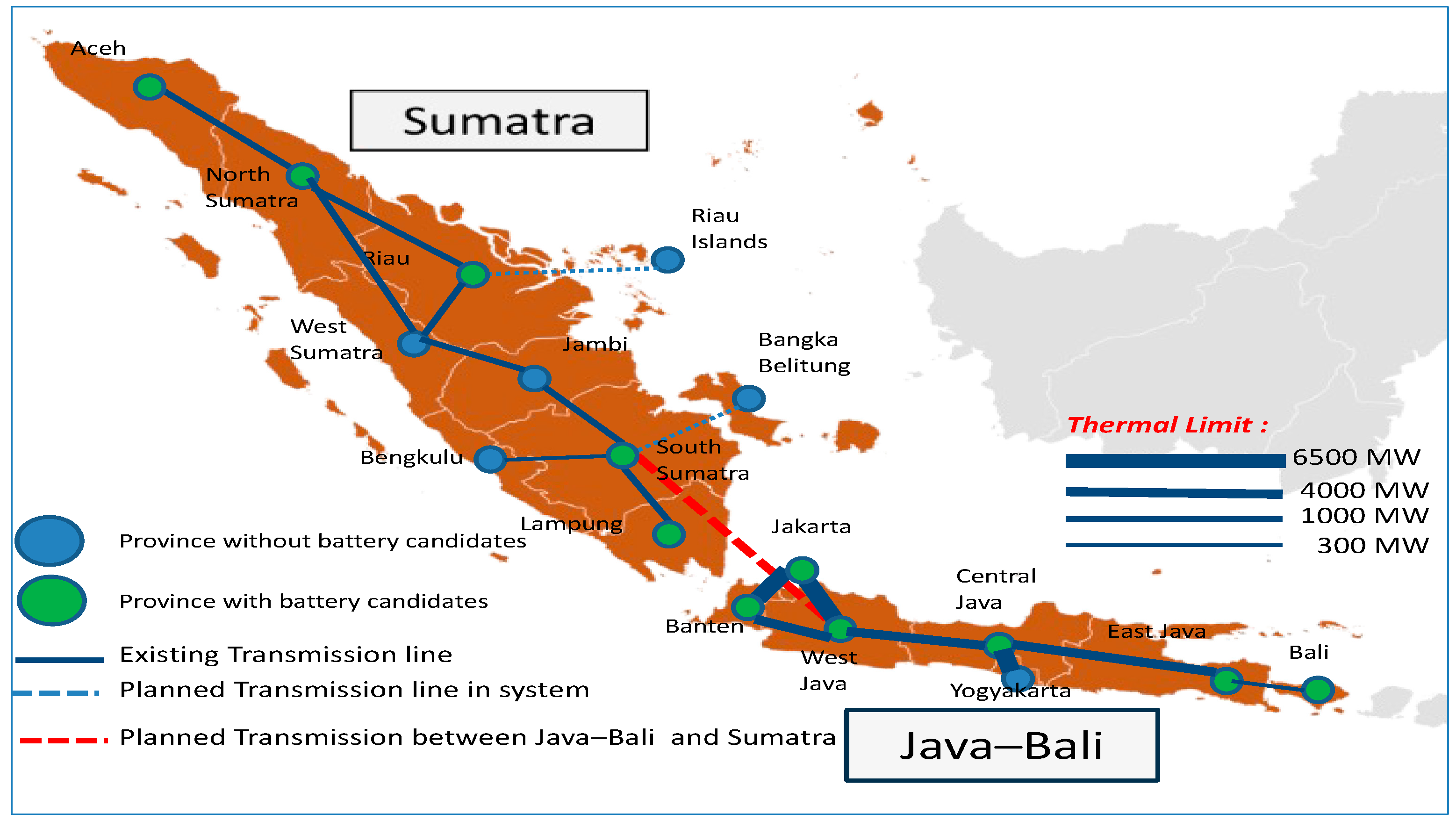
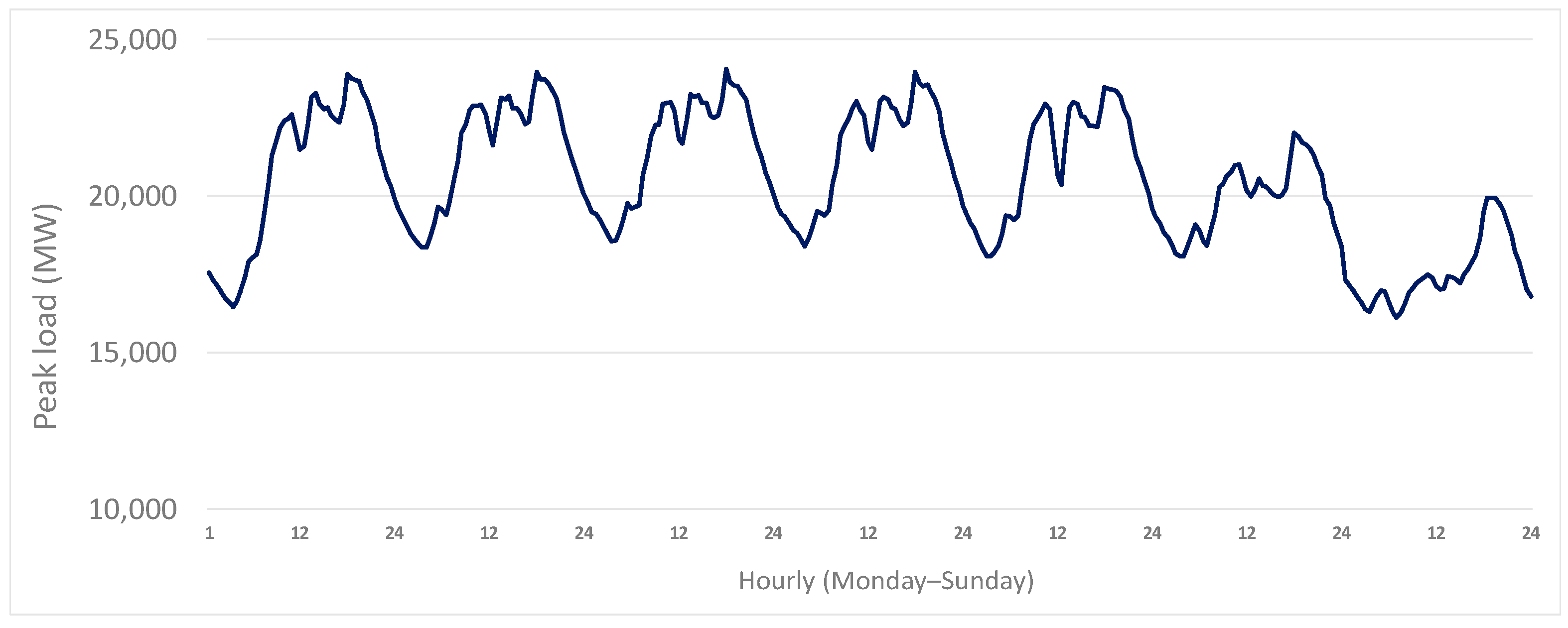
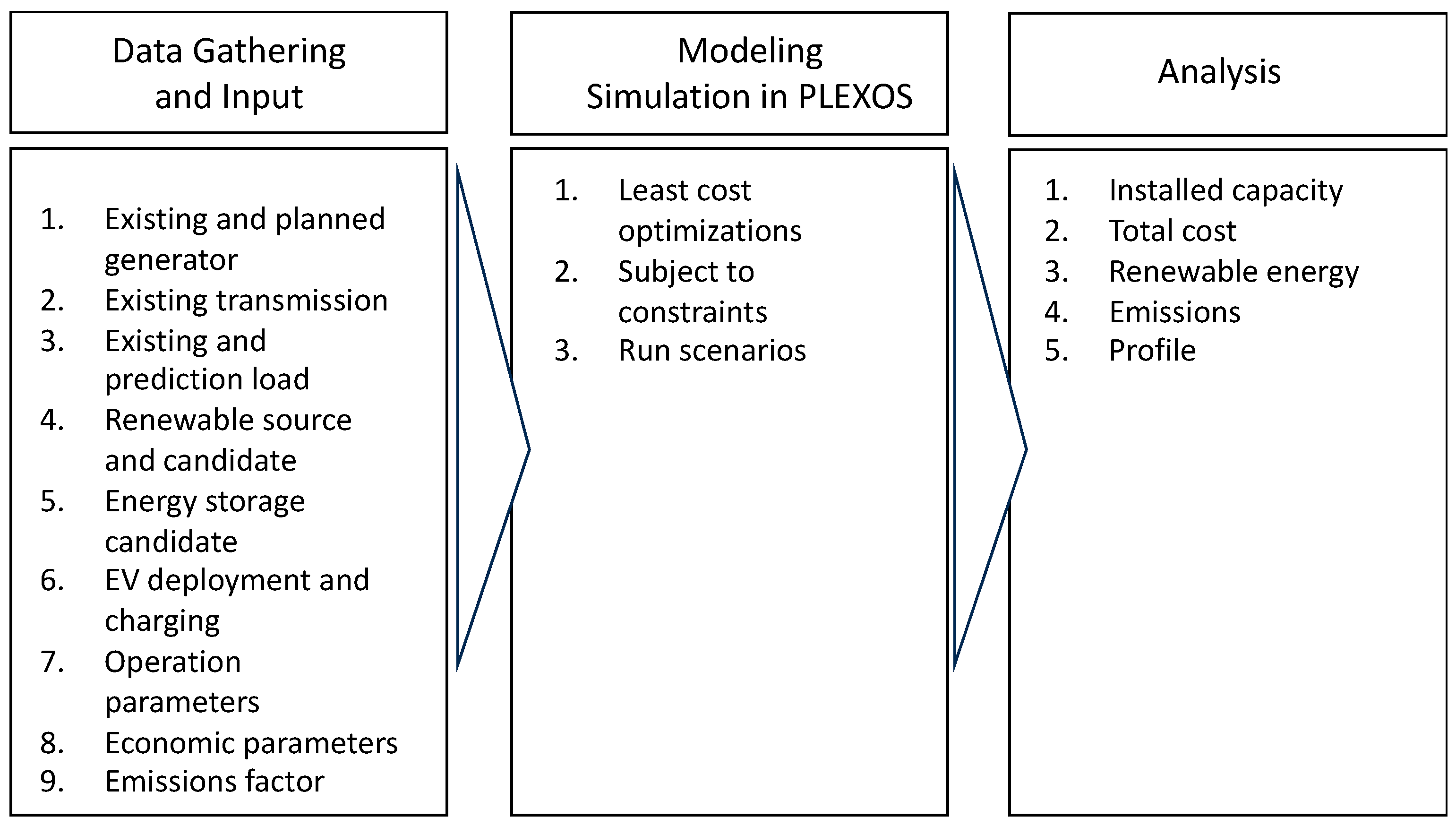
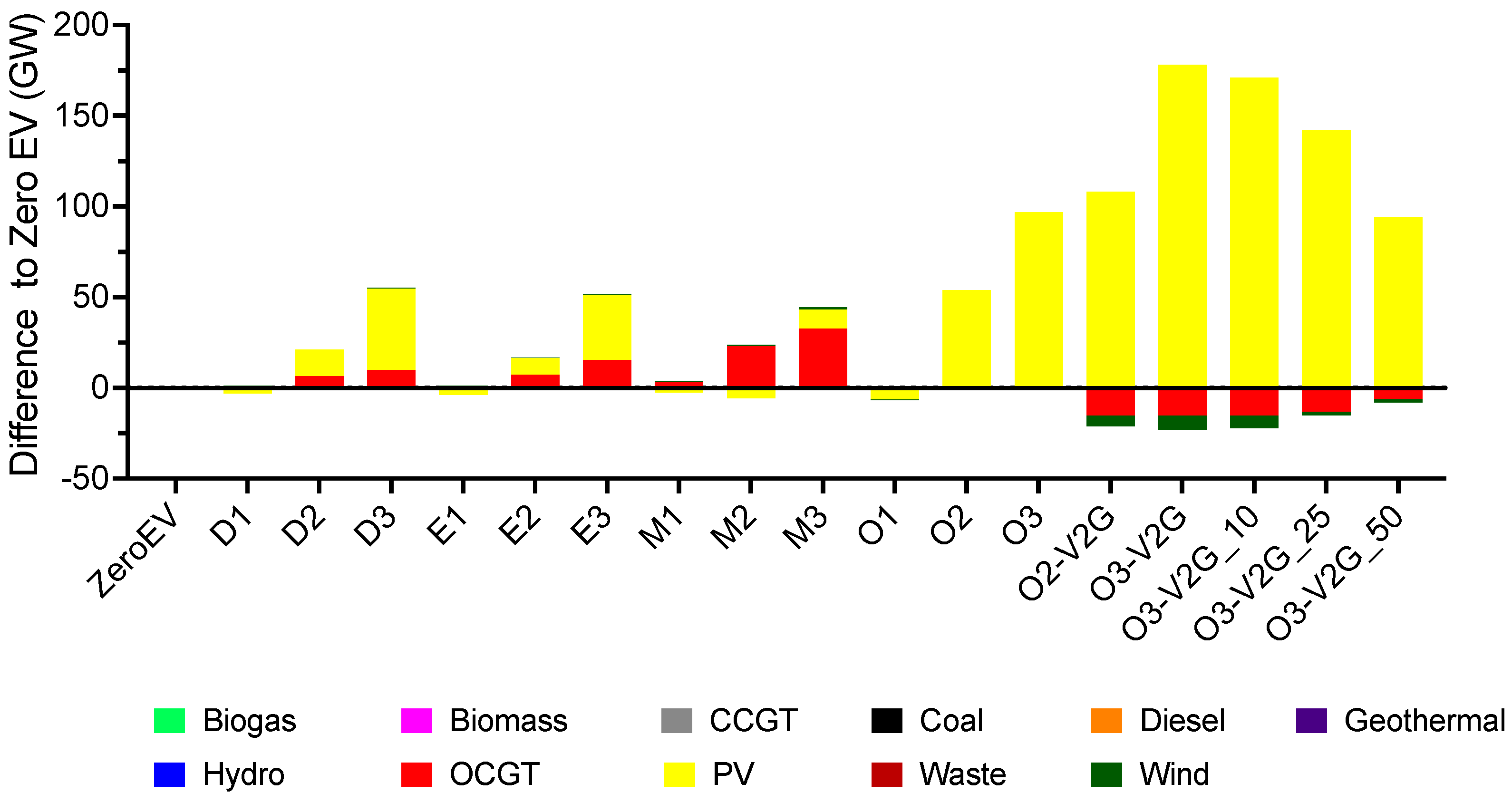
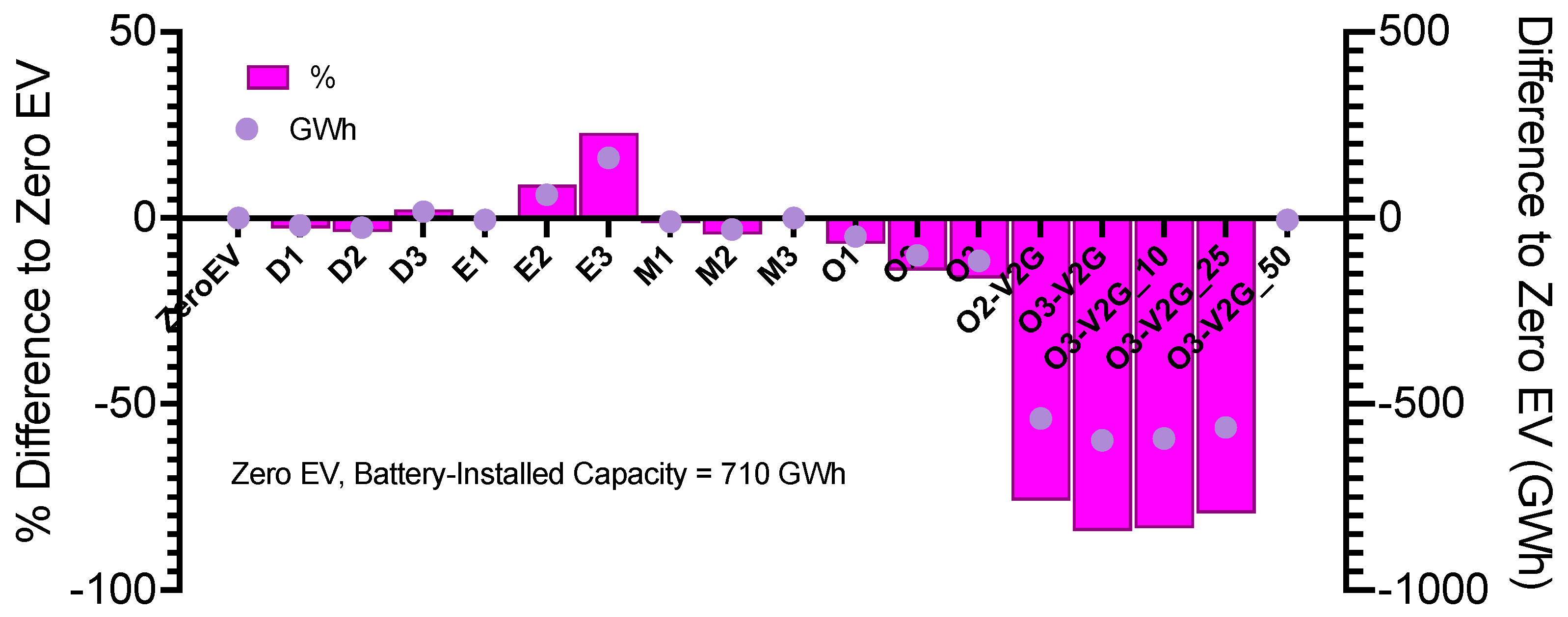
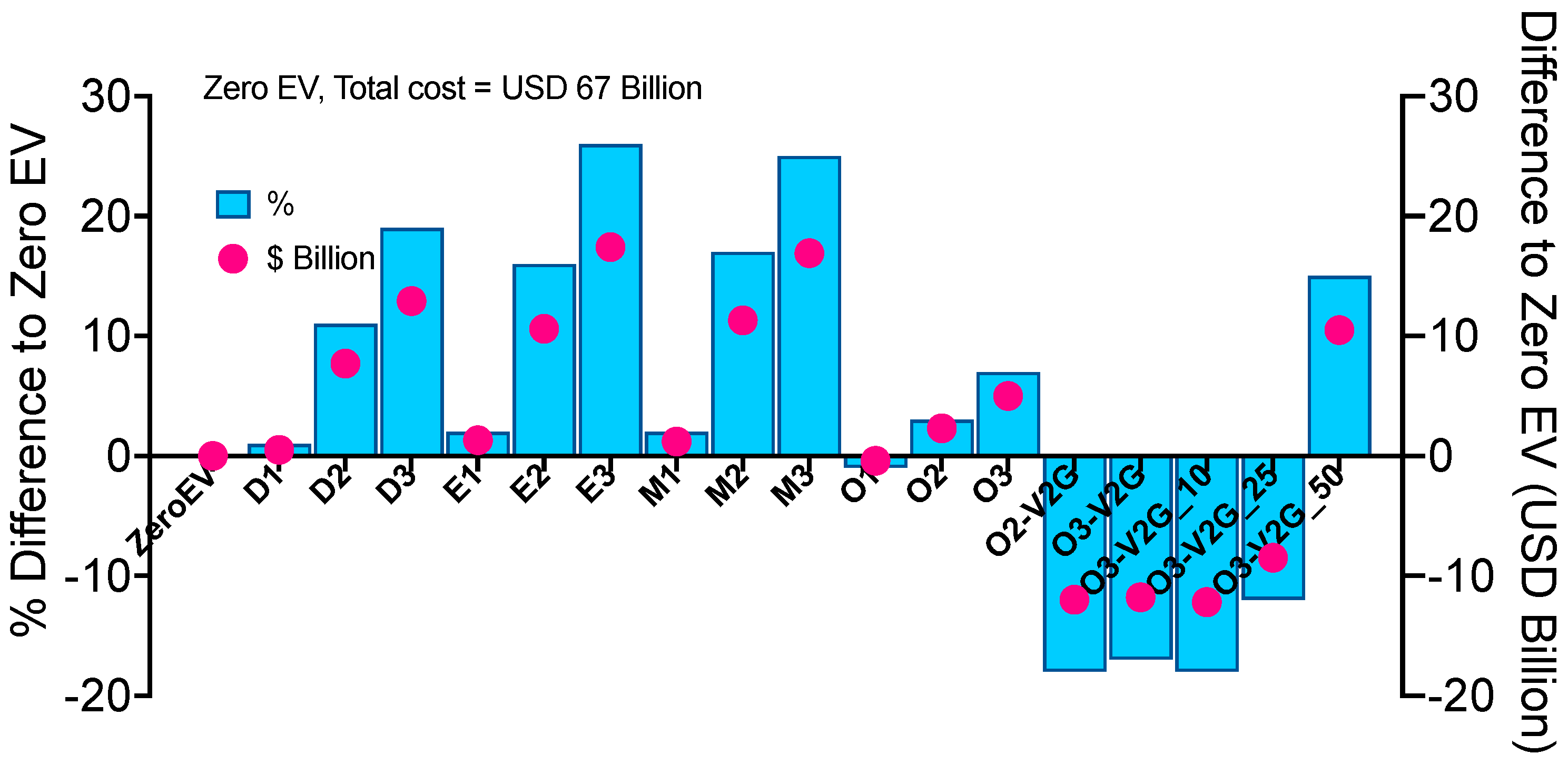

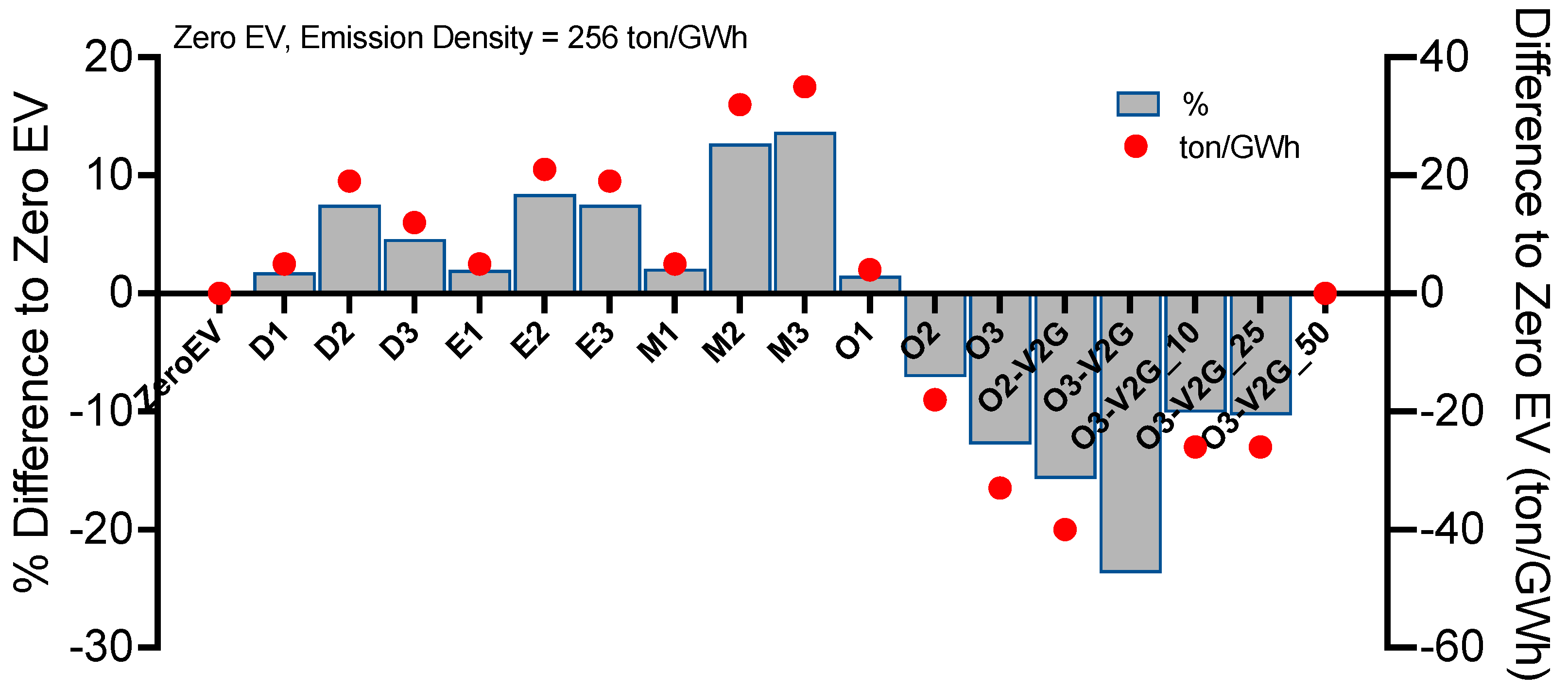

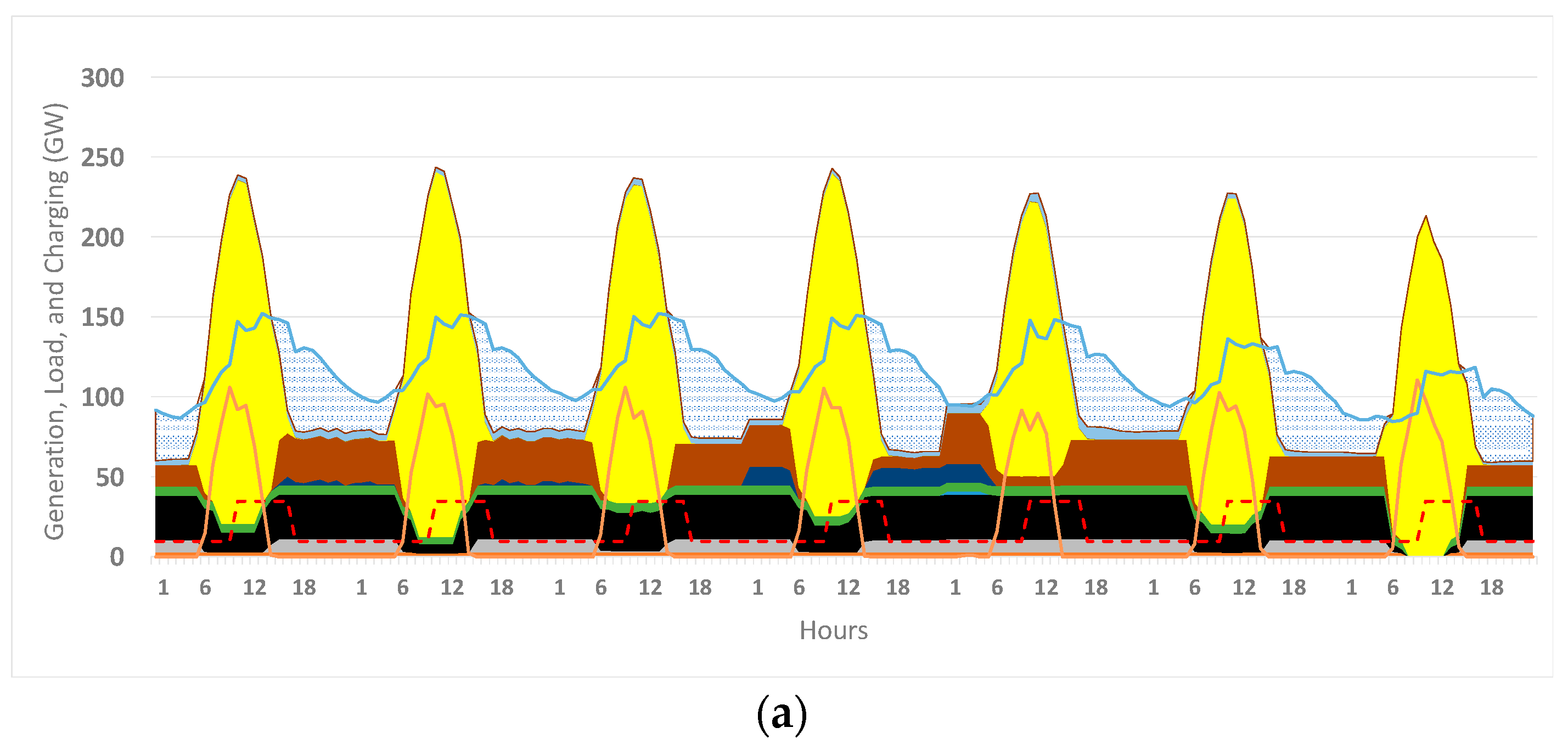
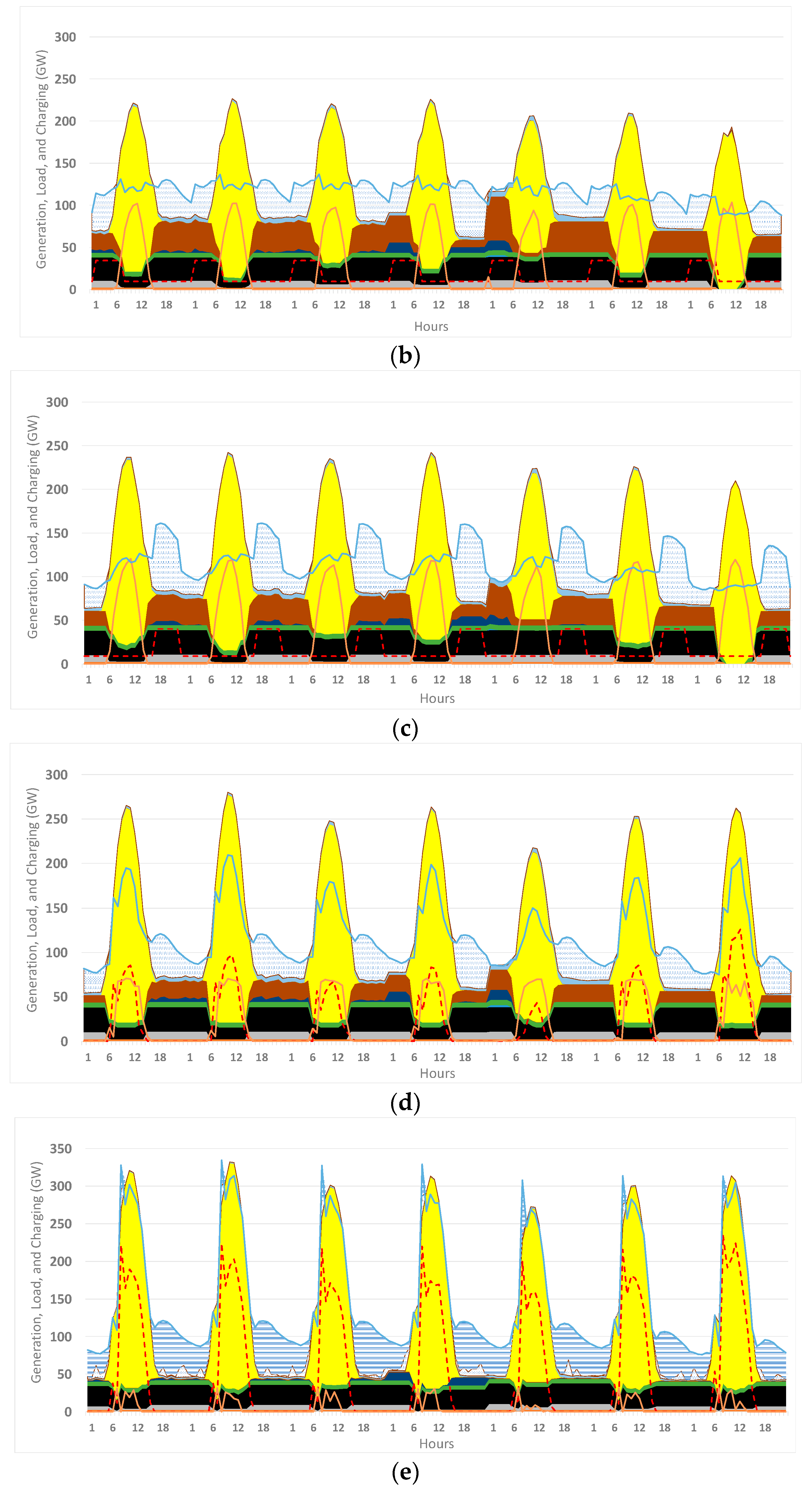

| Demand | Number of Electric Cars | Number of Electric Motorbikes |
|---|---|---|
| Base | 4.2 million (5% of the total) | 47 million (28% of the total) |
| Medium | 42 million (50% of the total) | 84 million (50% of the total) |
| High | 84 million (75% of the total) | 168 million (75% of the total) |
| Group | Name | Charging Time | V2G | Additional Cost for Charging Station (USD/MWh) | Demand EVs Scenarios | ||
|---|---|---|---|---|---|---|---|
| Base (1) | Medium (2) | High (3) | |||||
| Charging Time | Early Morning (M) | 1 AM–7 AM | - | - | M1 | M2 | M3 |
| Daytime (D) | 10 AM–4 PM | - | - | D1 | D2 | D3 | |
| Evening (E) | 5 PM–10 PM | - | - | E1 | E2 | E3 | |
| Optimized (O) | Optimized | - | - | O1 | O2 | O3 | |
| V2G Scenarios V2G Scenarios | Optimized + Vehicle to grid | Optimized | p | - | - | O2-V2G | O3-V2G |
| Optimized + Vehicle to grid_10 | Optimized | p | USD 10 | - | - | O3-V2G_10 | |
| Optimized + Vehicle to grid_25 | Optimized | p | USD 25 | - | - | O3-V2G_25 | |
| Optimized + Vehicle to grid_50 | Optimized | p | USD 50 | - | - | O3-V2G_50 | |
Disclaimer/Publisher’s Note: The statements, opinions and data contained in all publications are solely those of the individual author(s) and contributor(s) and not of MDPI and/or the editor(s). MDPI and/or the editor(s) disclaim responsibility for any injury to people or property resulting from any ideas, methods, instructions or products referred to in the content. |
© 2024 by the authors. Licensee MDPI, Basel, Switzerland. This article is an open access article distributed under the terms and conditions of the Creative Commons Attribution (CC BY) license (https://creativecommons.org/licenses/by/4.0/).
Share and Cite
Amiruddin, A.; Dargaville, R.; Liebman, A.; Gawler, R. Integration of Electric Vehicles and Renewable Energy in Indonesia’s Electrical Grid. Energies 2024, 17, 2037. https://doi.org/10.3390/en17092037
Amiruddin A, Dargaville R, Liebman A, Gawler R. Integration of Electric Vehicles and Renewable Energy in Indonesia’s Electrical Grid. Energies. 2024; 17(9):2037. https://doi.org/10.3390/en17092037
Chicago/Turabian StyleAmiruddin, Ahmad, Roger Dargaville, Ariel Liebman, and Ross Gawler. 2024. "Integration of Electric Vehicles and Renewable Energy in Indonesia’s Electrical Grid" Energies 17, no. 9: 2037. https://doi.org/10.3390/en17092037
APA StyleAmiruddin, A., Dargaville, R., Liebman, A., & Gawler, R. (2024). Integration of Electric Vehicles and Renewable Energy in Indonesia’s Electrical Grid. Energies, 17(9), 2037. https://doi.org/10.3390/en17092037







